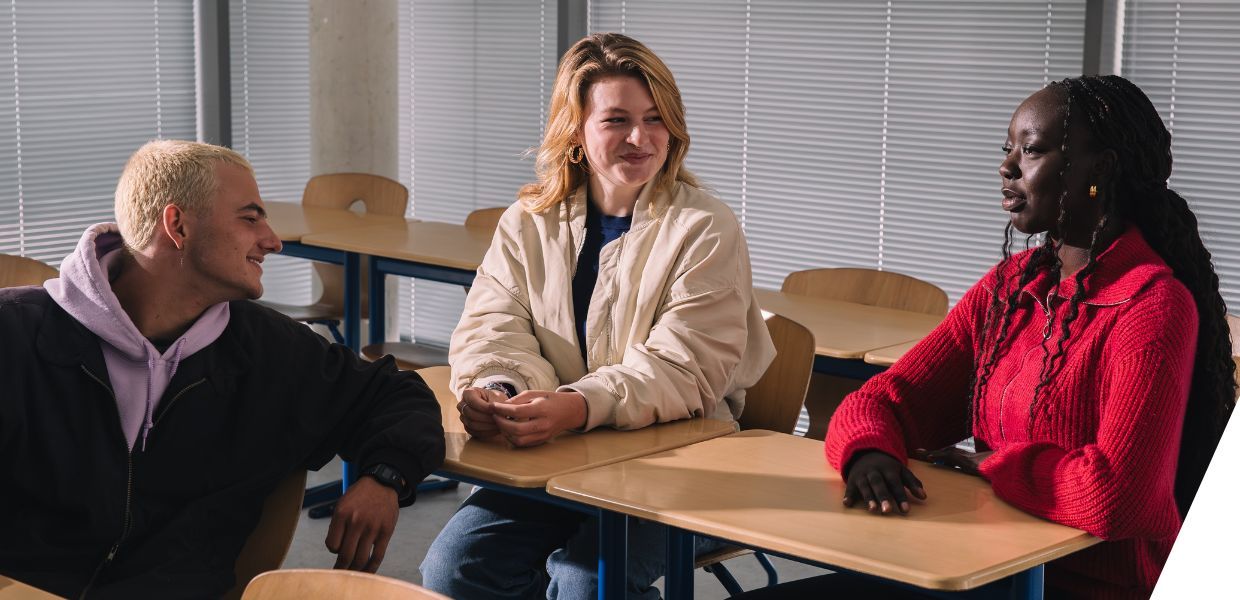’I wanted to share my story to empower others who face racism. Talking about our stories, about the discrimination we witness, is the first step to taking action.’
So says Wael, one of the many young voices featured in Stories that Move. This free online educational toolbox, developed by the Anne Frank House and international partners, is based around videos in which young people across Europe talk about their personal experiences with exclusion and prejudice.
Ready-to-use interactive teaching materials help learners navigate these stories, both individually online and in classroom discussions. Karen Polak, the international coordinator of Stories that Move, shares her insights and experiences in making a toolbox that is relevant and easy to use for educators across Europe, using digital storytelling techniques.
International network
‘A need for teaching materials against antisemitism was our starting point. As we progressed, we realised that a general approach might be better, as young people across Europe face many different forms of discrimination and we should address both the differences and the similarities of the history and impact of this discrimination,’ Karen explains.
Developing Stories that Move was a collaborative effort, bringing together organisations from seven countries. ‘We began by holding conferences, bringing together young people and teachers from around Europe. We wanted to hear what they needed and use their creativity about how to tackle a sensitive, complex topic. We gathered experiences from various minority groups.’ The resulting ‘toolbox’ reflects a broad range of stories and perspectives, making it relevant across cultural and national contexts.
Digital storytelling
The appeal of the personal stories has proved to be one of the toolbox’s greatest strengths. Martina, a teacher at a bilingual school in Austria, has been using the toolbox for lessons in history, English and citizenship. ‘It is very close to students’ lives. It uses the language that they use. It is not the educators’ language, so they can really relate to the stories.’
Karen says: ‘At the Anne Frank House, we know how powerful the voice of a young person can be. Personal stories, like that of Anne Frank, can connect us with others, fostering empathy and understanding. Research shows that empathy is an effective mechanism in reducing discrimination.’
Stories that resonate with their own lives ensure that students remain engaged in the lessons. Throughout the toolbox, learners are offered choices. ‘This is one of the most general educational principles that we incorporated in the toolbox. You don’t tell learners what to do, but you invite them to choose a story that interests them. In this way, they can feel ownership over their learning process.’
Historical narratives relevant today
Stories that Move includes 10 historical biographies, all stories of persecution or exclusion, accompanied by source materials. The toolbox encourages students to make the materials their own by finding creative ways to pass the stories on, perhaps by creating a poster or giving a presentation.
‘Using personal stories is an attractive entrance point to understand the relevance of history for our lives today. During several workshops young people helped us choose the stories, based on what they found inspiring. We wanted to include experiences with an international element, such as the story of Stefan Kosiński, a young Polish man who fell in love with a German soldier during the war,’ Karen explains.
By combining historical narratives with contemporary experiences, Stories that Move helps learners to understand the broader context of topics such as discrimination, media literacy, and democracy. ‘The historical stories are empowering. They show the impact that one person’s voice can have and that progress is possible,’ she says. ‘But at the same time, the contemporary stories show we aren’t there yet. The toolbox offers learners the feeling that they can make a positive change, while also educating them about the most prevailing forms of discrimination in Europe.’
Adapting to new needs
Creating a digital toolbox that fits the national curriculums of multiple countries presented challenges. Karen notes that, ‘The digital environment across Europe varies; not all schools have all the resources to work with Stories that Move as it is intended. For example, some schools don’t have Wi-Fi for all students. We have learned to adapt. We offer state-of-the-art teaching materials, but we added printable worksheets. We point out different ways to work with the materials, even if digital capacity is limited. The cross-border partnerships provided us with a large network of international educators, researchers and policymakers. This helps us stay on top of any changes in the curriculum and educational focus, particularly the growing emphasis on civic education in many countries.’
Use the Toolbox
The Stories that Move Toolbox consists of five learning paths with interactive assignments which look at discrimination, media literacy, identity and taking action. Educators can choose a topic or story that resonates with their learners, or ties in with current events and the curriculum. The tool uses blended learning and visible thinking methods, incorporating see-think-wonder routines that channel the natural curiosity of learners into careful observation. It is available in nine languages and is suitable for bilingual education/
Ready to get started? Create a free account on Storiesthatmove.org. Tutorial videos offer tips on creating a safe learning environment to discuss sensitive topics with learners.
The Anne Frank House also regularly hosts webinars for educators - join ‘Democracy is yours’ on 12 September 2024 to learn more about the pedagogical approach behind the toolbox.

